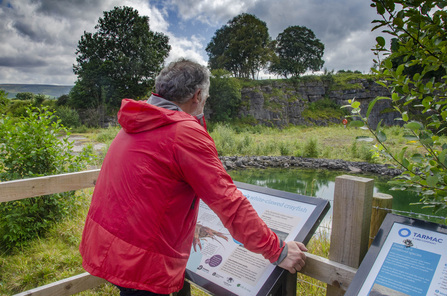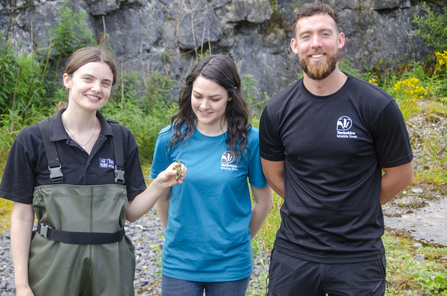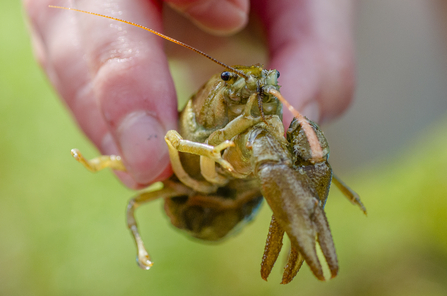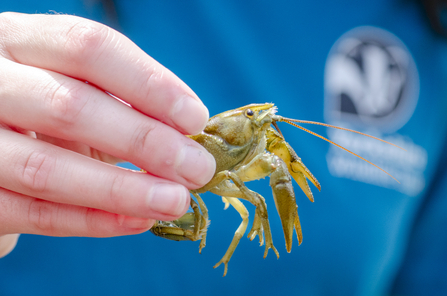While scrolling through posts in a local Facebook group, I spotted an advert for a ‘Curious About Crayfish’ event at Tarmac’s Threshfield Quarry, in the Yorkshire Dales. I was intrigued, as there is limited public access to the old quarry. - so I thought I'd go along and was delighted to find a splendid secret – an ark site for our native White-clawed crayfish. The crayfish ark is a safe haven for White-clawed crayfish. It was originally established by the Environment Agency and GSL Ecology. More recently Yorkshire Wildlife Trust has been involved in delivering habitat enhancements to the site. The ark site viewing platform can be accessed via public footpath through the site.
Vanessa Barlow, the Crayfish Stakeholder Officer with Yorkshire Wildlife Trust explained that ark sites are needed because our native crayfish could become extinct, if nothing is done to save them.

The White-clawed crayfish ark site at Threshfield Quarry. Photo credit, Telling our Story Volunteer - Sara
The White-clawed crayfish is the UK's only native freshwater crayfish. They are an important part of a river ecosystem, acting as ecosystem engineers by aiding in the breakdown of biological matter (such as leaf litter), feeding on algae and aquatic plants, as well as being food for otters, fish, newts and water voles. White-clawed crayfish live in freshwater streams and rivers, as well as still waterbodies such as reservoirs. They hide from predators underneath stones and rocks and in small crevices during the day and forage for food at night.
Yorkshire Wildlife Trust is part of the North Yorkshire Crayfish Forum. Founded in 2019, this partnership comprises environmental charities, government agencies, and national parks all working to protect the remaining White-clawed crayfish populations in North Yorkshire.
Vanessa Barlow, the Crayfish Stakeholder Officer with Yorkshire Wildlife Trust explained that ark sites are needed because our native crayfish could become extinct if nothing is done to save them. The main threat they face is from signal crayfish, an Invasive Non-Native Species (INNS), which is larger, more aggressive and can produce more young. As if that was not enough, signal crayfish also carry crayfish plague (a type of water mould) deadly to White-clawed crayfish!

Vanessa, holding a White-clawed crayfish, together with Rebecca from the North team and Alex from our Invasive Non-Native Species (INNS) team.
Photo Credit, Telling Our Story Volunteer - Sara
Crayfish Officer is certainly and unusual job title. Having always been interested in the freshwater environment, Vanessa said that when she saw the job advert it spoke to her. Adding with a smile, that she does think white-clawed crayfish are so cute!
She reported that she works with around 20 YWT volunteers, who are all trained in crayfish identification, surveying, measurement and in really strict biosecurity measures. These include thorough clean down and disinfection of equipment and footwear, to prevent cross contamination of sites.
The volunteers’ monitoring survey results are sent to the North Yorkshire Crayfish Forum and local ecological record centres, where they are used inform current and future work. Vanessa reported that one exciting new project is the Natural England’s Species Recovery Programme funded project, Claws for Thought: saving North Yorkshire's native crayfish. In this project Yorkshire Wildlife Trust with the Yorkshire Dales Rivers Trust, Flamingo Land and support from all members of the North Yorkshire Crayfish Forum will create new crayfish ark sites, enhance existing ark sites, and establish a captive rearing facility (to help bolster populations and support ark sites).

A close-up of a White-clawed crayfish, you have to admit - they do look pretty cute!
Photo credit, Telling Our Story Volunteer - Sara
Vanessa’s top tips on what you can do to support our native crayfish:
- Please don’t pick-up, catch or trap any crayfish you see. The different species can be hard to tell apart and you may accidentally harm one of our native crayfish.
- Avoid spreading crayfish plague (which can live for 2 weeks on damp clothing or equipment). Follow the Check, Clean, Dry guidelines here
- Spread the word, by telling others about our native crayfish, the threats they face and what the North Yorkshire Crayfish Forum is doing to support them. You can find out lots more about its work on the website: North Yorkshire Crayfish Forum (arcgis.com) and X (formerly Twitter) @NYCrayfishForum

The White-clawed crayfish needs your help, follow Vanessa's top tips to help protect them.
Photo credit, Telling Our Story Volunteer - Sara

